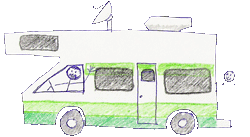


The next day (March 22), we drove about 60 miles to the west and Rock Hound State Park, just south of Deming, New Mexico. We knew that Lazy Dazers, Kate and Terry were camped there and we thought it would be fun to connect with them. Beth, another Lazy Dazer, was also there. Thank goodness we called ahead and they saved us a spot. The campground is very popular with rock hound people and retirees. We could see why it’s full most of the time. It’s one of the nicest state parks that we’ve stayed in. (If you like desert.)
The park was located on a southwestern slope of the Little Florida Mountains with a panoramic view of the Florida Mountains to the southwest. The campsites were large, well spaced apart, and offered a view of the gorgeous desert sunsets. The state park had walking trails, a museum, and a botanical garden. Many of the campsites had their own desert gardens. There was an abundance of wildlife and many of the flowers and cacti were blooming. The weather was warm during the day but cool at night and the wind could really blow at times.
The park was a rock hound’s paradise. You could collect rocks anywhere in the park. You were allowed to take out 15 pounds of rocks... Many of the campers had their rock hammers, bags, and some with polishing machines.
We saw lots of retirees and snow birds in New Mexico. They can buy a yearly pass for $225 (non-resident) and stay in any state campground. There is a limit of 21 days stay in any given park, but they only have to leave for 1 day and can return for another 21 days. The weather is great, the living is cheap and the New Mexico State Parks are very nice (so we’ve been told).
We’ve enjoyed exploring the local area. The town of Deming is just 10 miles away and has some great Mexican food restaurants. We love those huevos rancheros, the mild chilies, and the very reasonable prices.
While in Deming we enjoyed a blue grass presentation by the Bost family from Brisbee. Arizona. The seven members of the family gave quite a foot stomping presentation. Mom even had 2 year old William on her back while she played the base.
This area is mainly grassy plains, broken up with some mountain ranges. You have to be careful when driving around, because it is free range with the possibility of cattle crossing the road.
We are also not use to all the border patrol cars, vans, and SUVs. There are check points located on the various roads. We are only 30 miles from the Mexican border. There is also an Aerostat (balloon) tethered up in the sky, that we can see from our campsite. Presumably, it’s there to catch smugglers.
Kate and I did take a day trip down to Palomas, Mexico. It was about a 30 minute drive. We parked the car on the U.S. side and just walked across the border. It’s a very small town that caters to U.S. and Canadian citizens. Many people get their glasses, prescription drugs and even dental work done there. We also did some shopping and picked up some silver jewelry and pottery.
We celebrated John’s 65th birthday with a dinner party in our rig. Thanks to Kate, Terry and Beth for helping us celebrate. As you can see by the picture, it was a bit tight.
Thank you to everyone who sent birthday wishes to the old man.




















